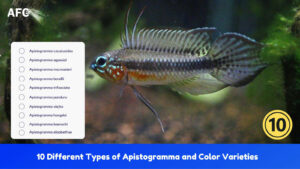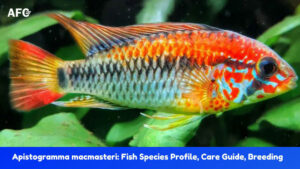Lace Catfish is one of the most popular fish species for aquarists around the world. It is prized not only for its striking pattern of lacy black markings and distinctive fin shape but also for its hardy nature and adaptability in a wide range of habitats.
Are you planning to add lace catfish to your aquarium? Here’s a comprehensive guide that will teach you about Lace Catfish care.
Species Summary
Lace catfish (Synodontis nigrita), known as the false upside down catfish, is found in Senegal and many other African countries, including Nigeria, Sudan, Egypt, and Ghana. They inhabit the lakes of the Great Rift Valley and other small ponds in the central and west parts of the continent.
Synodontis Catfish belongs to the family of Mochokidae catfish. The mochokids received their name due to the unique structure of their jaws and upside-down swimming pattern. Not all mochokids swim upside-down; Synodontis nigrita is one of them.
Additionally, mochokids are known as squeakers for their distinctive vocalizations. They can make stridulatory sounds through their pectoral fin when stressed or frightened. Sometimes, you might hear the squeak when removed from the water.
Their squeaking is a good warning signal to other mochokids and also to the predator.
| Scientific Name: | Synodontis nigrita |
| Common Name: | Lace catfish |
| Care Level: | Easy |
| Lifespan: | 8 – 10 years |
| Max Size: | 6 – 8 inches |
| Temperature: | 70 – 78.8°F |
| PH: | 6.0 – 7.6 |
| Water hardness: | 3 – 20 dKH |
| Diet: | Omnivore |
| Minimum Tank Size: | 29 gallons for single adult |
| Temperament: | Peaceful |
Appearance
Synodontis have a diverse range of colors and patterns, making them popular aquarium species. There are more than 120 species of Synodontis catfish. Most of them have some common features, but they have several other unique characteristics that set them apart from other types of catfish.
The body of Synodontis is elongated and oblate from the sides, and the back is slightly stretched. Most of the part is gray or brown-colored, depending on the particular species. Their mouth is a bit large and located deep in the bottom of the head.
The shape and size of the humeral process mainly help identify S. nigrita from its relatives. It has a longer humeral process with a ridge on the bottom end and pointed back. This fish also has a strong, bony head capsule, which extends back to the first spine of the dorsal fin.
Large dark spots all over the body, creating a camouflage pattern. Like many catfishes, Synodontis doesn’t have scales.
They have three pairs of flashy barbell merged plates perfect for crushing shells or anything that can fit into their mouths. The maxillary barbels are located on the upper jaw, and the other two pairs of mandibular barbles are on the lower jaw.
Their long and straight upper jaw barbel doesn’t have any branches but extends to a length of about 1 – 1 ⅔ times the length of their head. The mandibular barbels’ length is twice the inner pair’s length and comes with short branches.
Unlike other members of Synodontis, the spine of S. Nigrita’s dorsal fin is straight or slightly curved.
Lace Catfish Size
The average size of Lace Catfish is around 6- 8 inches in the aquarium, while some specimens can reach up to 13.2″ (33.5 cm) inches in the wild. It’s quite common for most never to reach this length. Generally, female Lace Catfish tend to be larger than males.
The growth rate of Lace Catfish (Synodontis nigrita) is not uniform throughout their lifetime. Both males and females grow rapidly during the first year, and then the growth rate slows down.
Lifespan
The expected typical lifespan of these catfish is around 8 – 10 years; however, there have been reports of some fish living up to 25 years.
Like other fish species, Synodontis Nigrita also suffers from health issues, which might shorten their life span. The hobbyists must take care of these fishes and give them a proper diet to add more years to their lives.
Care & Tank Set Up
Lace catfish might not be the first choice for those searching for easy to care catfish because of their adult size. However, a good aquarium set up with a medium pH and hardness is enough to keep the fish healthy.
While they are easy to maintain, they still have specific requirements that you should be mindful of. Here, we have covered the basics of setting up a suitable aquarium environment for Synodontis Nigrita so they will not rumble all the time.
Tank Size
A full-grown Lace catfish needs a tank size of at least 29 gallons (30″ x 12″ x 18″). If you have the means to keep a small group of adults, we recommend 55 gallons (48″ x 13″ x 21″) aquarium or more.
You can start smaller with juveniles in the tank with 50 gallons or at least 48 inches long. Their territorial aggression levels increase with age and size.
You are free to go even bigger to add more species to your tank. Always remember that lace catfish require ample room to swim around. Provide them with enough hiding spaces to make them feel comfortable in their new habitat.
Water Parameters
View this post on InstagramA post shared by @fish_onmymind
Unlike these amazing African Cichlids that are mainly found in the Tanganyika and Malawi Lakes, Synodontis inhabits quiet backwaters as well as small pools and ponds.
The best course of action when it comes to Lace Catfish is to mimic their natural habitat by keeping the water parameters as close as possible.
Lace catfish are fairly hardy fish that can tolerate a range of water parameters, but they prefer the following:
- Temperature: 70 – 78.8°F
- pH: 6.0 – 7.6
- Water Hardness: 3 – 20 dKH
- Ammonia: 0ppm
- Nitrite: 0ppm
- Nitrate: <20ppm
Their big size means they will produce a lot of waste, so it is necessary to use a good filter system to keep the water clean. An external canister filtration system is the best choice to do the job.
To maintain these parameters and keep Lace Catfish healthy and thriving in your aquarium, you will need to regularly monitor water chemistry and perform partial water changes.
Plants, Substrate & Lighting
A well-designed tank is crucial for the Lace Catfish. While Synodontis does not require any special substrate or plants, you will want to add some natural elements to the tank to make them feel at home.
Being a hardy bottom scavenger, these fish prefer a soft sandy substrate as they may use their barbels to sift through substrates in search of food.
Plants are good decorations for Lace Catfish aquaria, as they can provide a great hiding space and aesthetic features, but they are not essential. Lace catfish do well with most aquarium plants, especially these floating vegetation common in their natural habitat.
A good amount of driftwood, rocks or even PVC tubes can also be used as hiding spaces or shady areas. However, you should never put any sharp element to protect their delicate antennae in the aquarium soil.
These freshwater fish prefer dim lighting. Bright lighting can make them unsettled and stressed. So, choose a low to moderate light output for your Lace Catfish aquarium.
Remember to cover your heater with a piece of material to avoid Lace Catfish from contacting it by mistake. Lace catfish are known for their curious nature and can burn themselves if heated too high.
Food & Diet
Synodontis nigrita is an omnivore with insatiable appetite. They can eat just about anything and spend most of their time searching for leftovers. You can use quality Sinking pellets or tablet food for their staple diet.

- Superior Benefits Over Live Foods: Specially developed for the needs of most carnivorous fish, without...
- Extremely Palatable: Developed after extensive study and analysis of the sense of sight, smell and taste...
- An X-Large Pellet Big Fish Love: A porous pellet that softens quickly by rapidly absorbing water. This...
- Natural Beauty They Desire: Most monster fish come from the natural environments high in UV which...
- Developed, produced and packaged in our facilities so we can be assured you'll always get the Hikari...
You can feed them live or frozen foods. Bloodworms, shrimp, and tubifex worms work well. Do not overfeed, as it will lead to bloating and other digestive problems.
You should also offer some vegetable matter, such as cucumber and peas, and occasional algae wafers to get the fiber they need.
View this post on InstagramA post shared by FishTankJourney (@fishtankjourney)
Lace Catfish Tank Mates
The Lace Catfish is generally peaceful but can be territorial as the fish mature, so don’t get surprised if you see some sparing here and there. They prefer staying in groups whenever possible.
Avoid putting small fish because Lace Catfish will eat them without hesitation. You can add other members of Synodontis, but the tank needs to be quite large and provide many hiding spots.
Adult Lace Catfish are usually territorial and aggressive towards other Synodontis and small bottom feeders, like Corydoras or Otocinclus.
It is not recommended to keep these fish in a general community aquarium due to their adult size. Beyond other small fish, you can try:
- Medium-sized tetras
- Tropheus moorii (Blunthead Cichlid)
- Gouramis
- Knifefish
- Large Loricariids,
- Rainbowfish
- Mormyrids
- Robust West African cichlid
Breeding
Unfortunately, there are no reported cases of Lace Catfish breeding in captivity, but they have been commercially bred using hormone injections.
Recently, a xanthic color morph began popping up in aquariums around the world, which might be a result of selective breeding or lack of pigmentation.
Whatever the technique may be, it’s clear that these exciting “Gold,” “Yellow,” “Mustard,” Lace Catfish are having a profound impact on how we view this fascinating species.
Final Thoughts
So, that concludes with a lace catfish care guide. Synodontis Nigrita looks incredibly beautiful and distinctive, making them one of the leading choices of fish keepers. We hope our in-depth research will assist you in keeping these beautiful and peaceful fishes in your tank without any hassle.
Owing these catfishes is an absolute delight in itself. So, add them to your tank now and have fun while observing them.
Let us know if you have any questions about this species in the comments section below. Good luck!





